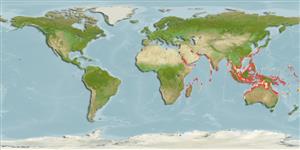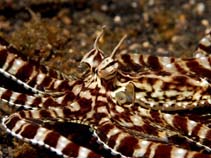Thaumoctopus mimicus Norman & Hochberg, 2005
Mimic octopus| Native range | All suitable habitat | Point map | Year 2050 |

|
| This map was computer-generated and has not yet been reviewed. |
| Thaumoctopus mimicus AquaMaps Data sources: GBIF OBIS |
Classification / Names Common names | Synonyms | CoL | ITIS | WoRMS
Cephalopoda | Octopoda | Octopodidae
Environment: milieu / climate zone / depth range / distribution range Ecology
Benthic; depth range 0 - 37 m (Ref. 96968). Tropical
Distribution Countries | FAO areas | Ecosystems | Occurrences | Introductions
Indo-West Pacific.
Length at first maturity / Size / Weight / Age
Maturity: Lm ? range ? - ? cm Max length : 48.0 cm TL male/unsexed; (Ref. 96968)
Mantle length is 5.8 cm. Species is known for its mimicry of toxic models that co-occur in the same habitat, namely banded soles, sea snakes, and lionfish, with other distinct postures and behaviors currently being open to interpretation (Ref. 96968). This octopus often occupies the vacated burrows of other animals. These lairs appear temporary or may form a network of regular lairs within a home range. Individuals were observed to occupy a particular hole for periods of between one to four days. Some individuals were observed to leave one hole at first light, forage throughout the day (including entering and exiting from various animal burrows throughout the day) and remain overnight within the last hole encountered during foraging bouts. These animals were observed to emerge from the same hole at first light the next day (Ref. 96968). Active during the day. Feeds on crustaceans and fishes (Ref. 7940).
Life cycle and mating behavior Maturity | Reproduction | Spawning | Eggs | Fecundity | Larvae
Members of the class Cephalopoda are gonochoric. Male and female adults usually die shortly after spawning and brooding, respectively. Mating behavior: Males perform various displays to attract potential females for copulation. During copulation, male grasp the female and inserts the hectocotylus into the female's mantle cavity where fertilization usually occurs. Life cycle: Embryos hatch into planktonic stage and live for some time before they grow larger and take up a benthic existence as adults.
Main reference
References | Coordinator | Collaborators
Norman, M.D. and F.G. Hochberg. 2005. (Ref. 7940)
IUCN Red List Status (Ref. 130435)
Least Concern (LC) ; Date assessed: 13 July 2016
CITES status (Ref. 108899)
Not Evaluated
CMS (Ref. 116361)
Not Evaluated
Threat to humans
Harmless
Human uses
| FishSource |
Tools
More information
Age/Size
Growth
Length-weight
Length-length
Morphology
Larvae
Abundance
Growth
Length-weight
Length-length
Morphology
Larvae
Abundance
Internet sources
BHL | BOLD Systems | CISTI | DiscoverLife | FAO(Publication : search) | Fishipedia | GenBank (genome, nucleotide) | GloBI | Gomexsi | Google Books | Google Scholar | Google | PubMed | Tree of Life | Wikipedia (Go, Search) | Zoological Record
Estimates based on models
Preferred temperature
(Ref. 115969): 24.8 - 29.3, mean 28.5 (based on 3299 cells).



